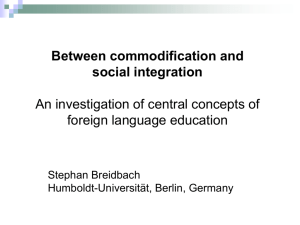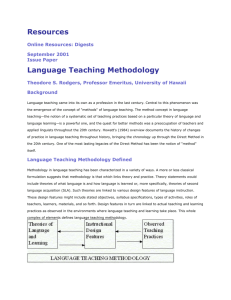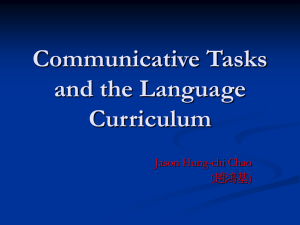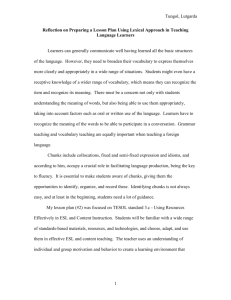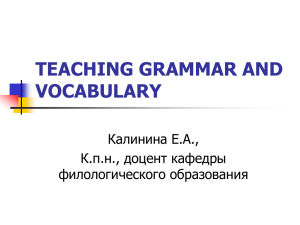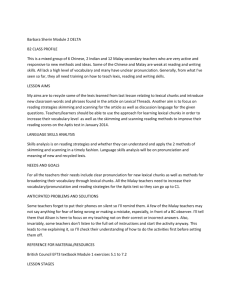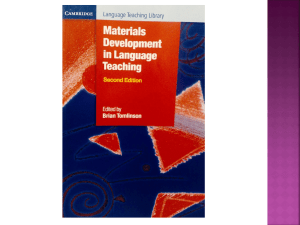More ESL Methods
advertisement
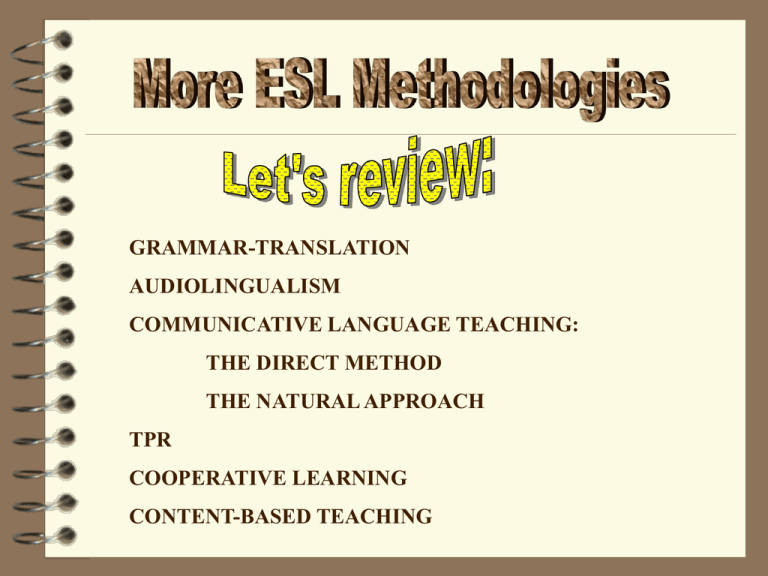
GRAMMAR-TRANSLATION AUDIOLINGUALISM COMMUNICATIVE LANGUAGE TEACHING: THE DIRECT METHOD THE NATURAL APPROACH TPR COOPERATIVE LEARNING CONTENT-BASED TEACHING •Originated in the early 1970s •Author: Caleb Gattegno •Three basic tenets: •learning is facilitated if the learner discovers •learning is aided by physical objects •problem-solving is central to learning The teacher should be “silent” in the classroom in order to encourage the students to produce as much language as possible. Presentation of language: •highly structured approach •language is taught through sentences •sequence based on grammatical complexity •the structural patterns are presented by the teacher--ONCE •the grammar rules are learned inductively by the learners •the teacher introduces a new item when needed •use of cuisenaire rods The role of the teacher is to “teach, test, and get out of the way.” (Earl W. Stevick) CRITICISM: •apparent lack of real communication •good for teaching only the very basics of the language •rigid structures •limited to relatively small groups of learners Originally developed in the 1970s by the Bulgarian educator Georgi Lozanov •Based on the power of suggestion in learning •Positive suggestion would make the learner more receptive and stimulate learning To create a relaxed state in the learner and to promote learning , suggestopedia uses: •music •a comfortable and relaxing environment •a student/teacher relationship akin to child/parent relationship MUSIC IS CENTRAL TO THE APPROACH There is no apparent theory of language and no obvious order in which items of language are presented. The original form of suggestopedia consisted of: •Use of extended dialogues •Vocabulary lists •Observations on grammatical rules •Teacher would read the dialogues aloud to the accompaniment of music. •“Concert reading” would typically employ a piece of classical music such as a Beethoven symphony, not as background, but as the main focus of the reading. In theory, large chunks of the dialogues would be internalized by the learners during the readings . Criticism: •little evidence to support the claims of success •classical music is not stimulating for everybody •length of the dialogues may confuse rather than motivate •the relaxing environment is beyond the means of most educational settings Task-based learning is typically based on three stages: 1. Pre-task stage: the teacher introduces and defines the topic and the learners engage in activities that help to recall or learn the words necessary for the performance of the task. 2. “Task cycle” The learners perform the task (a reading or listening exercise or a problem-solving exercise) in pairs or small groups. Then they prepare a report for the whole class on how they did the task and what conclusions they reached. 3. The learners present their findings to the entire class in spoken or written form. This is the language focus stage--specific language functions are highlighted and worked out. ADVANTAGES: •Language is used for a genuine purpose •All four language skills are integrated •The range of tasks offers a great deal of flexibility If Task-Based Learning is integrated with a systematic approach to grammar and lexis, the outcome can be adapted to meet the needs of all learners. Source: Jane Willis (1996). A Framework for Task-Based Learning An approach patterned upon counseling techniques and adapted to the personal and language problems a person may encounter in the learning of a foreign language. The instructorcounselor becomes an “other-language self” for the client. The counselors first acts as a mediator between the client and the group. Later, the client becomes increasingly independent and speaks directly to the group. A communicative approach that stresses a means of organizing a language syllabus. (Finocchiaro and Brumfit) NOTIONS: meaning elements that may be expressed through nouns, pronouns, verbs, prepositions, conjunctions, adjectives, adverbs. The use of particular notions depends on three major factors: 1. The functions 2. The elements in the situation 3. The topic being discussed A situation may affect: •variations of language •the formality or informality of the language •the mode of expression Functional Categories of Language: 1. PERSONAL 4. REFERENTIAL 2. INTERPERSOANAL 5. IMAGINATIVE 3. DIRECTIVE The lexical approach makes a distinction between vocabulary-traditionally understood as a stock of individual words with fixed meanings, and lexis, which includes single words and word combinations that we store in our mental lexicons. Lexical advocates argue that language consists of meaningful chunks. When combined, they produce coherent text. Taxonomy of lexical items (Lewis): •words •polywords •collocations or word partnerships •institutionalized utterances •sentence frames and heads; text frames Activities used to develop lexis: •intensive and extensive listening and reading •L1 and L2 comparisons and translations •repetition and recycling of activities •guessing the meaning of vocabulary from context •noticing and recording language patterns and collocations •working with dictionaries and other reference tools The underlying principle of the lexical approach is that language production is not a syntactic rulegoverned process, but is instead the retrieval of larger phrasal units from memory. (Zimmerman) Implementing a lexical approach does not lead to radical methodological changes, but rather involves a change in the teacher’s mindset. “The best methods are therefore those that supply comprehensible input in low anxiety situations, containing messages that students really want to hear.” Stephen D. Krashen

